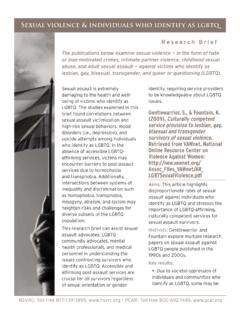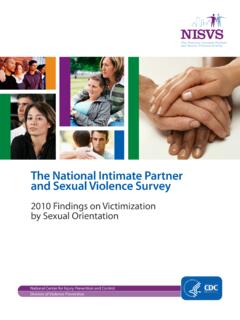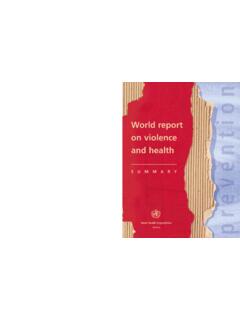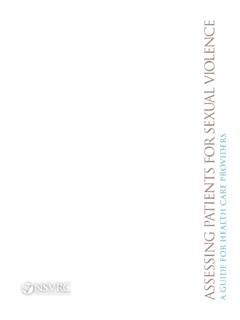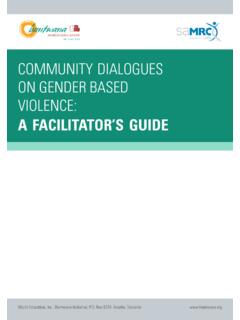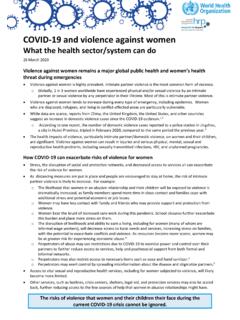Transcription of Intersection of Intimate Partner Violence and HIV in Women
1 1 Centers for Disease Control and PreventionIntersection of Intimate Partner Violence and HIV in WomenMechanismsExposure to IPV can increase Women s risk for human immunodeficiency virus (HIV) infection through What We Know about IPV and HIV in Women Intimate Partner Violence (IPV) includes physical Violence , sexual Violence , threats of physical or sexual Violence , stalking and psychological aggression (including coercive tactics) by a current or former Intimate Findings from the 2010 National Intimate Partner and Sexual Violence Survey (NISVS)
2 Indicate that of Women in the United States have experienced rape, physical Violence , or stalking by an Intimate Partner in their lifetime, and or million Women experienced these forms of Violence in the year prior to the In addition, 1 in 5 Women have experienced an attempted, completed, or alcohol-drug facilitated rape (defined as a physically forced or threatened vaginal, oral, and/or anal penetration) in their lifetime, mostly by a current or former Partner . Approximately 80% of female victims of rape experienced their first rape before the age of Nearly 1 in 2 Women have experienced other forms of sexual Violence in their lifetime ( , sexual coercion, unwanted sexual contact).
3 2 Over million people in the United States are estimated to be living with HIV and nearly 1 in 5 is unaware of their ,4 Approximately 50,000 Americans become infected with HIV each Women and adolescent girls accounted for 20% of new HIV infections in the United States in 20103 and represented approximately 21% of HIV diagnoses among adults and adolescents in African Americans bear the greatest burden of HIV among Women ; Hispanic Women are disproportionately affected. Of new infections in 2010, 64% occurred in blacks, 18% were in whites, and 15% were in The rate of new infections among black Women was 20 times that of white Women , and over 4 times the rate among Hispanic/Latina The most common methods of HIV transmission among Women are high-risk heterosexual contact (87% for black Women , 86% for Hispanic Women )
4 And injection drug ,4 forced sex with an infected Partner limited or compromised negotiation of safer sex practices increased sexual risk-taking behaviors Source: Maman, S. et al. 2000. The intersections of HIV and Violence : Directions for future research and interventions. Social Science & Medicine 50(4) between IPV and HIVThe association between Violence against Women and risk for HIV infection has been the focus of a growing number of studies. Findings from these studies indicate: Women and men who report a history of IPV victimization are more likely than those who do not to report behaviors known to increase the risk for HIV, including injection drug use, treatment for a sexually transmitted infection (STI), giving or receiving money or drugs for sex, and anal sex without a condom in the past year.
5 This is true even when other factors such as demographic characteristics, other unhealthy behaviors (smoking, heavy drinking, high body mass index) and negative health conditions ( , stroke, disability, and asthma) are HIV-positive Women in the United States experience IPV at rates that are higher than for the general Across a number of studies, the rate of IPV among HIV-positive Women (55%) was double the national rate, and the rates of childhood sexual abuse (39%) and childhood physical abuse (42%) were more than double the national Rates of Violence victimization among HIV-positive Women are comparable to those for HIV-negative Women drawn from similar populations and with similar levels of HIV risk However, HIV-positive Women may experience abuse that is more frequent and more ,8 Women in relationships with Violence have four times the risk for contracting STIs, including HIV, than Women in relationships without , 13-15 Fear of Violence can influence whether some Women get tested for HIV.
6 However, in one US study, fear of Partner notification and Partner Violence were not statistically associated with Women s decisions to get or not get an HIV Sexual abuse in childhood and forced sexual initiation in adolescence are associated with increased HIV risk-taking behaviors, including sex with multiple partners, sex with unfamiliar partners, sex with older partners, alcohol-related risky sex, anal sex, and low rates of condom use17-20 as well as HIV infection,21 in adult Women . Studies of HIV-Positive WomenSeveral studies have examined the relationship between Violence and the timing of becoming infected with HIV or disclosing HIV status.
7 These studies suggest that IPV can be both a risk factor for HIV, and a consequence of HIV. A history of victimization is a significant risk factor for unprotected sex for both HIV-positive Women and HIV-positive Women and gay/bisexual men reporting a history of Violence perpetration are also more likely to report engaging 3in unprotected sex, particularly when drugs were used in conjunction with HIV serostatus disclosure may be an initiating or contributing factor for Partner , 24 In US samples, of HIV-positive Women report experiencing Violence following HIV serostatus Violence perceived to be triggered by HIV disclosure was as high in years following diagnosis as in the initial year of Relationship Violence and trauma history can compromise the health and prevention practices of Women living with HIV.
8 Recently abused Women have more than 4 times the rate of antiretroviral therapy failure, and of not practicing safe sex, as Women who have not experienced abuse Studies of Women with a History of Abuse Forced sex occurs in approximately 40 to 45 percent of physically violent Intimate relationships and increases a woman s risk for STIs by 2 to 10 times that of physical abuse ,14 Women who had ever experienced forced sex were more likely to report HIV risk behaviors but less likely to have been tested for HIV despite greater perceived likelihood of having HIV than non-abused Women who had been physically abused as adults were only one-fifth as likely to report consistent condom use after two safer sex counseling sessions as Women who had not been Women who had experienced both physical and sexual Violence , compared to Women who reported physical Violence alone.
9 Were more likely to have had a recent STI (14% vs. 4%), to have had an STI during the relationship (43% vs. 20%), to use alcohol as a coping behavior (72% vs. 47%), and to have been threatened when negotiating condom use (35% vs. 10%).15 Women who experience IPV or sexual Violence are at greater risk for a range of adverse health consequences, including increased prevalence of stress, depression, and chronic anxiety than their non-abused A recent national study found that Women who experienced rape or stalking by any perpetrator or physical Violence by an Intimate Partner in their lifetime were more likely than Women who did not experience these forms of Violence to report having asthma, diabetes, and irritable bowel syndrome.
10 And both Women and men who experienced these forms of Violence were more likely to report frequent headaches, chronic pain, difficulty sleeping, activity limitations, poor physical health, and poor mental health than Women and men who did not experience these forms of Significant associations have also been found between IPV and altered red blood cell and decreased T-cell function32,33 and relationships between stress, depression, Women who had ever experienced forced sex were more likely to report HIV risk behaviors but less likely to have been tested for HIV.










